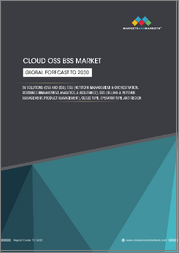
|
시장보고서
상품코드
1702199
OSS 및 BSS 시장 규모, 점유율, 동향, 예측 : 컴포넌트, OSS와 BSS 솔루션 유형, 전개 방식, 조직 규모, 업계별, 지역별(2025-2033년)OSS & BSS Market Size, Share, Trends and Forecast by Component, OSS & BSS Solution Type, Deployment Mode, Organization Size, Industry Vertical, and Region 2025-2033 |
||||||
OSS 및 BSS 시장 세계 시장 규모는 2024년에 658억 1,000만 달러에 달했습니다. 향후 IMARC Group은 2033년에는 1,482억 6,000만 달러에 달할 것으로 예상하며, 2025-2033년 CAGR은 9.4%에 달할 것으로 예측하고 있습니다. 현재 북미가 시장을 독점하고 있으며, 2024년에는 35.6% 이상의 큰 시장 점유율을 차지했습니다. 시장을 주도하는 것은 통신 부문의 대폭적인 확장, 소비자의 기대치 상승, 네트워크 속도, 용량, 연결성을 향상시키는 5세대 기술의 등장입니다.
운영 지원 시스템(OSS)은 운영체제 및 통신 네트워크를 관리하기 위한 소프트웨어입니다. 이는 네트워크 계획을 처리하고 네트워크에 연결된 컴퓨터, 라우터, 서버 등의 네트워크 인벤토리를 관리합니다. 한편, 비즈니스 지원 시스템(BSS)은 제품, 고객, 수익, 주문 등의 핵심 비즈니스 활동 및 관리 기능을 지원하고 자동화합니다. OSS와 BSS가 제공하는 특징적이고 기능적인 기능으로 인해 현재 일부 조직은 비즈니스의 다양한 영역을 효율적으로 관리하기 위해 두 가지 도구를 통합하는 데 주력하고 있습니다.
OSS 및 BSS 시장 동향:
통신 인프라가 크게 개선되고 데이터 소비가 증가함에 따라 통신 사업자와 공급자는 마케팅, 제품 제공, 판매, 계약, 서비스 제공과 같은 비즈니스 기능을 지원하는 OSS 및 BSS 플랫폼에 의존하고 있습니다. 이는 효율적인 포트폴리오 및 통신 사이트 관리 소프트웨어에 대한 수요 증가, 개인화, 원활한 서비스 이용, 통신 산업 및 플랫폼 간 다양성에 대한 관심으로 인해 더욱 강화되고 있습니다. 이와는 별도로, 디지털화되고 효율적인 비즈니스 프로세스를 구축하기 위한 산업 자동화 및 비즈니스 인텔리전스(BI), 인공지능(AI), 머신러닝(ML) 기술의 사용이 증가하고 있는 것도 전 세계 5G 애플리케이션 및 서비스 수요에 영향을 미치고 있습니다. 그 결과, 통신 사업자가 최종 소비자의 진화하는 요구에 대응할 수 있도록 지원하는 OSS 및 BSS 플랫폼의 시장 성장이 강화되고 있습니다. 이와 더불어, 과금 시스템 간소화, 고객 경험 개선, 비즈니스 민첩성 향상에 대한 수요 증가는 전 세계적으로 클라우드 OSS 및 BSS 도구의 판매를 촉진할 것으로 예상됩니다.
본 보고서에서 다루는 주요 질문
- OSS 및 BSS 시장의 시장 규모는?
- OSS 및 BSS 시장의 향후 전망은?
- OSS 및 BSS 시장을 주도하는 주요 요인은 무엇인가?
- OSS 및 BSS 시장 점유율이 가장 높은 지역은?
- OSS 및 BSS 시장 세계 시장에서 주요 기업은?
- OSS 및 BSS 시장 세계 시장 내 산업별 비중은?
- OSS 및 BSS 시장의 세계 주요 지역은?
- 세계 OSS 및 BSS 시장의 주요 플레이어/기업은?"
목차
제1장 서문
제2장 조사 범위와 조사 방법
- 조사 목적
- 이해관계자
- 데이터 소스
- 1차 정보
- 2차 정보
- 시장 추정
- 상향식 접근
- 하향식 접근
- 조사 방법
제3장 주요 요약
제4장 소개
- 개요
- 주요 업계 동향
제5장 세계의 OSS 및 BSS 시장
- 시장 개요
- 시장 실적
- COVID-19의 영향
- 시장 예측
제6장 시장 내역 : 구성요소별
- 솔루션
- 서비스
제7장 시장 내역 : OSS 및 BSS 솔루션 유형별
- 네트워크 계획과 설계
- 서비스 제공
- 서비스 이행
- 서비스 보증
- 청구 및 수익 관리
- 네트워크 성능 관리
- 고객 및 제품 관리
- 기타
제8장 시장 내역 : 전개 방식별
- 온프레미스
- 클라우드 기반
제9장 시장 내역 : 조직 규모별
- 중소기업
- 대기업
제10장 시장 내역 : 업계별
- IT 및 통신
- BFSI
- 미디어와 엔터테인먼트
- 소매업과 E-Commerce
- 기타
제11장 시장 내역 : 지역별
- 북미
- 미국
- 캐나다
- 아시아태평양
- 중국
- 일본
- 인도
- 한국
- 호주
- 인도네시아
- 기타
- 유럽
- 독일
- 프랑스
- 영국
- 이탈리아
- 스페인
- 러시아
- 기타
- 라틴아메리카
- 브라질
- 멕시코
- 기타
- 중동 및 아프리카
- 시장 내역 : 국가별
제12장 SWOT 분석
- 개요
- 강점
- 약점
- 기회
- 위협
제13장 밸류체인 분석
제14장 Porter's Five Forces 분석
- 개요
- 구매자의 교섭력
- 공급 기업의 교섭력
- 경쟁 정도
- 신규 참여업체의 위협
- 대체품의 위협
제15장 가격 분석
제16장 경쟁 구도
- 시장 구조
- 주요 기업
- 주요 기업 개요
- Amdocs
- Cisco Systems Inc.
- Comarch SA
- Hewlett Packard Enterprise Development LP
- Huawei Technologies Co. Ltd.
- Infosys Limited
- Netcracker Technology Corporation(NEC Corporation)
- Nokia Corporation
- Oracle Corporation
- Suntech S.A.
- Telefonaktiebolaget LM Ericsson
The global OSS & BSS market size was valued at USD 65.81 Billion in 2024. Looking forward, IMARC Group estimates the market to reach USD 148.26 Billion by 2033, exhibiting a CAGR of 9.4% during 2025-2033. North America currently dominates the market, holding a significant market share of over 35.6% in 2024. The market is driven by the significant expansion of the telecommunication sector, rising consumer expectations, and the emergence of fifth generation technology to improve network speed, capacity, and connectivity.
An operation support system (OSS) is a software used to manage the operating system or communication networks. It handles network planning and maintains network inventories, such as computers, routers, and servers that are connected to a network. On the other hand, a business support system (BSS) supports and automates core business activities and management functions, such as product, customer, revenue, and order. It also provides information about customer relationships, payment orders, and new sign-ups. Due to the distinct and functional features offered by OSS and BSS, several organizations nowadays are focusing on incorporating both the tools to manage different areas of businesses efficiently.
OSS & BSS Market Trends:
With significant improvements in telecom infrastructure and increasing data consumption, telecom operators and providers are currently relying on OSS and BSS platforms to support business functions, including marketing, product offerings, sales, contracting, and delivery of services. This is further supported by the rising need for efficient portfolio and telecom site management software and the focus on personalization, seamless service usage, and diversity across communication industries and platforms. Apart from this, the rising usage of industrial automation and business intelligence (BI), artificial intelligence (AI), and machine learning (ML) technologies for building efficient digitized business processes are influencing the demand for 5G applications and services worldwide. This, in turn, is strengthening the market growth of the OSS and BSS platform that enables telecom operators to tackle the evolving needs of the end consumers. Besides this, the growing demand for streamlining billing systems, enhancing customer experiences, and improving business agility is anticipated to promote the sales of cloud OSS and BSS tools across the world.
Key Market Segmentation:
Breakup by Component:
- Solution
- Services
Breakup by OSS & BSS Solution Type:
- Network Planning and Design
- Service Delivery
- Service Fulfillment
- Service Assurance
- Billing and Revenue Management
- Network Performance Management
- Customer and Product Management
- Others
Breakup by Deployment Mode:
- On-premises
- Cloud-based
Breakup by Organization Size:
- Small and Medium-sized Enterprises
- Large Enterprises
Breakup by Industry Vertical:
- IT and Telecom
- BFSI
- Media and Entertainment
- Retail and E-Commerce
- Others
Breakup by Region:
- North America
- United States
- Canada
- Asia-Pacific
- China
- Japan
- India
- South Korea
- Australia
- Indonesia
- Others
- Europe
- Germany
- France
- United Kingdom
- Italy
- Spain
- Russia
- Others
- Latin America
- Brazil
- Mexico
- Others
- Middle East and Africa
Competitive Landscape:
The competitive landscape of the industry has also been examined along with the profiles of the key players being Amdocs, Cisco Systems Inc., Comarch SA, Hewlett Packard Enterprise Development LP, Huawei Technologies Co. Ltd., Infosys Limited, Netcracker Technology Corporation (NEC Corporation), Nokia Corporation, Oracle Corporation, Suntech S.A. and Telefonaktiebolaget LM Ericsson.
Key Questions Answered in This Report
- 1.How big is the OSS & BSS market?
- 2.What is the future outlook of the OSS & BSS market?
- 3.What are the key factors driving the OSS & BSS market?
- 4.Which region accounts for the largest OSS & BSS market share?
- 5.Which are the leading companies in the global OSS & BSS market?
- 9. What is the breakup of the global OSS & BSS market based on the industry vertical?
- 10. What are the key regions in the global OSS & BSS market?
- 11. Who are the key players/companies in the global OSS & BSS market?"
Table of Contents
1 Preface
2 Scope and Methodology
- 2.1 Objectives of the Study
- 2.2 Stakeholders
- 2.3 Data Sources
- 2.3.1 Primary Sources
- 2.3.2 Secondary Sources
- 2.4 Market Estimation
- 2.4.1 Bottom-Up Approach
- 2.4.2 Top-Down Approach
- 2.5 Forecasting Methodology
3 Executive Summary
4 Introduction
- 4.1 Overview
- 4.2 Key Industry Trends
5 Global OSS & BSS Market
- 5.1 Market Overview
- 5.2 Market Performance
- 5.3 Impact of COVID-19
- 5.4 Market Forecast
6 Market Breakup by Component
- 6.1 Solution
- 6.1.1 Market Trends
- 6.1.2 Market Forecast
- 6.2 Services
- 6.2.1 Market Trends
- 6.2.2 Market Forecast
7 Market Breakup by OSS & BSS Solution Type
- 7.1 Network Planning and Design
- 7.1.1 Market Trends
- 7.1.2 Market Forecast
- 7.2 Service Delivery
- 7.2.1 Market Trends
- 7.2.2 Market Forecast
- 7.3 Service Fulfillment
- 7.3.1 Market Trends
- 7.3.2 Market Forecast
- 7.4 Service Assurance
- 7.4.1 Market Trends
- 7.4.2 Market Forecast
- 7.5 Billing and Revenue Management
- 7.5.1 Market Trends
- 7.5.2 Market Forecast
- 7.6 Network Performance Management
- 7.6.1 Market Trends
- 7.6.2 Market Forecast
- 7.7 Customer and Product Management
- 7.7.1 Market Trends
- 7.7.2 Market Forecast
- 7.8 Others
- 7.8.1 Market Trends
- 7.8.2 Market Forecast
8 Market Breakup by Deployment Mode
- 8.1 On-premises
- 8.1.1 Market Trends
- 8.1.2 Market Forecast
- 8.2 Cloud-based
- 8.2.1 Market Trends
- 8.2.2 Market Forecast
9 Market Breakup by Organization Size
- 9.1 Small and Medium-sized Enterprises
- 9.1.1 Market Trends
- 9.1.2 Market Forecast
- 9.2 Large Enterprises
- 9.2.1 Market Trends
- 9.2.2 Market Forecast
10 Market Breakup by Industry Vertical
- 10.1 IT and Telecom
- 10.1.1 Market Trends
- 10.1.2 Market Forecast
- 10.2 BFSI
- 10.2.1 Market Trends
- 10.2.2 Market Forecast
- 10.3 Media and Entertainment
- 10.3.1 Market Trends
- 10.3.2 Market Forecast
- 10.4 Retail and E-Commerce
- 10.4.1 Market Trends
- 10.4.2 Market Forecast
- 10.5 Others
- 10.5.1 Market Trends
- 10.5.2 Market Forecast
11 Market Breakup by Region
- 11.1 North America
- 11.1.1 United States
- 11.1.1.1 Market Trends
- 11.1.1.2 Market Forecast
- 11.1.2 Canada
- 11.1.2.1 Market Trends
- 11.1.2.2 Market Forecast
- 11.1.1 United States
- 11.2 Asia-Pacific
- 11.2.1 China
- 11.2.1.1 Market Trends
- 11.2.1.2 Market Forecast
- 11.2.2 Japan
- 11.2.2.1 Market Trends
- 11.2.2.2 Market Forecast
- 11.2.3 India
- 11.2.3.1 Market Trends
- 11.2.3.2 Market Forecast
- 11.2.4 South Korea
- 11.2.4.1 Market Trends
- 11.2.4.2 Market Forecast
- 11.2.5 Australia
- 11.2.5.1 Market Trends
- 11.2.5.2 Market Forecast
- 11.2.6 Indonesia
- 11.2.6.1 Market Trends
- 11.2.6.2 Market Forecast
- 11.2.7 Others
- 11.2.7.1 Market Trends
- 11.2.7.2 Market Forecast
- 11.2.1 China
- 11.3 Europe
- 11.3.1 Germany
- 11.3.1.1 Market Trends
- 11.3.1.2 Market Forecast
- 11.3.2 France
- 11.3.2.1 Market Trends
- 11.3.2.2 Market Forecast
- 11.3.3 United Kingdom
- 11.3.3.1 Market Trends
- 11.3.3.2 Market Forecast
- 11.3.4 Italy
- 11.3.4.1 Market Trends
- 11.3.4.2 Market Forecast
- 11.3.5 Spain
- 11.3.5.1 Market Trends
- 11.3.5.2 Market Forecast
- 11.3.6 Russia
- 11.3.6.1 Market Trends
- 11.3.6.2 Market Forecast
- 11.3.7 Others
- 11.3.7.1 Market Trends
- 11.3.7.2 Market Forecast
- 11.3.1 Germany
- 11.4 Latin America
- 11.4.1 Brazil
- 11.4.1.1 Market Trends
- 11.4.1.2 Market Forecast
- 11.4.2 Mexico
- 11.4.2.1 Market Trends
- 11.4.2.2 Market Forecast
- 11.4.3 Others
- 11.4.3.1 Market Trends
- 11.4.3.2 Market Forecast
- 11.4.1 Brazil
- 11.5 Middle East and Africa
- 11.5.1 Market Trends
- 11.5.2 Market Breakup by Country
- 11.5.3 Market Forecast
12 SWOT Analysis
- 12.1 Overview
- 12.2 Strengths
- 12.3 Weaknesses
- 12.4 Opportunities
- 12.5 Threats
13 Value Chain Analysis
14 Porters Five Forces Analysis
- 14.1 Overview
- 14.2 Bargaining Power of Buyers
- 14.3 Bargaining Power of Suppliers
- 14.4 Degree of Competition
- 14.5 Threat of New Entrants
- 14.6 Threat of Substitutes
15 Price Analysis
16 Competitive Landscape
- 16.1 Market Structure
- 16.2 Key Players
- 16.3 Profiles of Key Players
- 16.3.1 Amdocs
- 16.3.1.1 Company Overview
- 16.3.1.2 Product Portfolio
- 16.3.1.3 Financials
- 16.3.2 Cisco Systems Inc.
- 16.3.2.1 Company Overview
- 16.3.2.2 Product Portfolio
- 16.3.2.3 Financials
- 16.3.2.4 SWOT Analysis
- 16.3.3 Comarch SA
- 16.3.3.1 Company Overview
- 16.3.3.2 Product Portfolio
- 16.3.3.3 Financials
- 16.3.4 Hewlett Packard Enterprise Development LP
- 16.3.4.1 Company Overview
- 16.3.4.2 Product Portfolio
- 16.3.4.3 Financials
- 16.3.4.4 SWOT Analysis
- 16.3.5 Huawei Technologies Co. Ltd.
- 16.3.5.1 Company Overview
- 16.3.5.2 Product Portfolio
- 16.3.5.3 SWOT Analysis
- 16.3.6 Infosys Limited
- 16.3.6.1 Company Overview
- 16.3.6.2 Product Portfolio
- 16.3.6.3 Financials
- 16.3.6.4 SWOT Analysis
- 16.3.7 Netcracker Technology Corporation (NEC Corporation)
- 16.3.7.1 Company Overview
- 16.3.7.2 Product Portfolio
- 16.3.8 Nokia Corporation
- 16.3.8.1 Company Overview
- 16.3.8.2 Product Portfolio
- 16.3.8.3 Financials
- 16.3.8.4 SWOT Analysis
- 16.3.9 Oracle Corporation
- 16.3.9.1 Company Overview
- 16.3.9.2 Product Portfolio
- 16.3.9.3 Financials
- 16.3.9.4 SWOT Analysis
- 16.3.10 Suntech S.A.
- 16.3.10.1 Company Overview
- 16.3.10.2 Product Portfolio
- 16.3.11 Telefonaktiebolaget LM Ericsson
- 16.3.11.1 Company Overview
- 16.3.11.2 Product Portfolio
- 16.3.11.3 Financials
- 16.3.11.4 SWOT Analysis
- 16.3.1 Amdocs



















